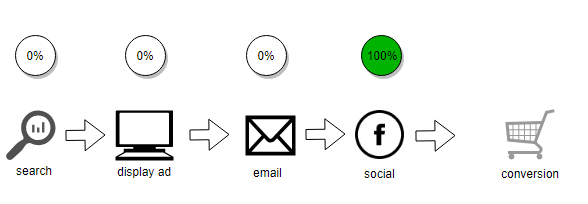2 Introduction
2.1 What is attribution modelling
The ideal world for marketers is that customers will fall in love with your products or services and make a purchase the first time they see an advertisement. But, the truth is the customer might have hundreds of interactions with a brand before they make a purchase. Actually, they might get exposed to the products or services through different marketing channels such as social media, other web sites, search engines and apps etc.
So why do we care about this? The ultimate aim is to arm decision makers with the data needed to make complex decisions. We do this by measuring the return on investment (ROI) of marketing efforts. In Jayawardane et. al (2015) they discuss how customers who interact with a brand across multiple channels bring in more value. While it is typical to have parallel streams of marketing efforts, it is not straightforward to understand which of these channels actually helped make the conversion and to what extent.
We present a tour of methods that solve this problem with practical implementation guides and code examples. We aim to give decision makers the data to understand the true return from each channel and therefore guide marketing strategy in a data driven way.
2.2 Definitions
In this guide we talk about the ‘customer pathway’ or the ‘conversion journey’. We define this as the sequence of steps a customer takes when interacting with a brand which will ultimately lead to either the customer converting or not converting.

We say conversion to mean the user has completed a desired action. This may indeed be purchasing an item from a website eStore, however in other domains this may simply mean signing up to a service or newsletter or completing some other pre-defined action.
2.3 Scope of this paper
First we break down the types of models that solve this attribution problem in different ways.
For each type of approach we present an explanation and a practical example of how they work as well as a review of their strengths and weaknesses.
At Internetrix, we are accredited Google Partners and support clients with tracking and optimising their online presence using tools from the Google Marketing Platform. We review the existing methods that are available in tools like Google Analytics and Analytics 360.
However, this guide is largely aimed at users who want to customise and extend these methods and tailor them to their specific company goals. We present a toolkit using the R programming language, complete with reproducible code examples to showcase attribution modelling methods, from the very basic to more complicated and powerful algorithms.
In doing this, we use example data from Google Analytics 360 and BigQuery. We cover the often neglected steps of how to query and prepare this data for modelling. However, for users who collect their digital marketing data in other platforms, the implementation guides will still be relevant and valuable.
Finally we extend attribution modelling in a bonus section to cover offline attribution. That is, measuring the impact of channels outside the digital sphere like TV, radio, billboard etc. This unlocks some powerful tools to extend beyond what is tracked from your website.
2.4 Where to go for further help
While not a complete guide, we hope it provides some insights to the various methods that can help arm your organisation with the data to make effective marketing decisions.
For further help please reach out to us any time:
Internetrix Data Science
Web: https://www.internetrix.com.au/services/data-science/
Phone: +61242535300
email: irx.info@internetrix.com.au